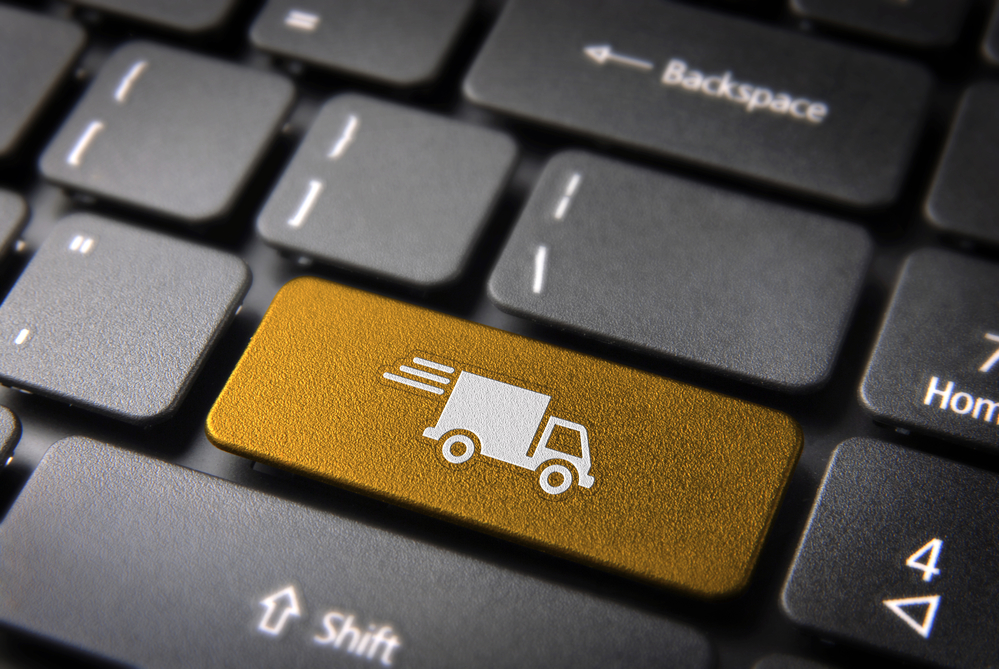

Welcome to Shipping School! If you’re reading this, it probably means you’re interested in learning more about all things shipping. Maybe you’re an eCommerce business owner looking to save money on postage. Maybe you want to figure out how to ship fragile stuff without breaking it. Whatever the case, we’re happy you’re here! This crash course is all about the basics of shipping, but before we dive into the nitty gritty, let us take a minute to tell you a little bit about us.
Table of Contents
- The eCommerce Invasion
- Let’s Talk About Shipping
- Don’t Overlook the Packaging
- Meet the Major Carriers in the U.S.
- Postage, Postage, Postage
- Wrapping up the Shipping Basics
The eCommerce Invasion
Robots are taking over the world! Okay, so maybe robots aren’t taking over per se, but eCommerce absolutely is. In 2017 alone, consumers spent $453.46 billion on online retail purchases. In fact, eCommerce accounted for 13% of the ENTIRE United States retail market in 2017—and that number is just going to keep growing. That means there are more opportunities now than ever before to join the movement and develop your very own eCommerce business! That also means you’ve got a lot to learn about the basics of shipping, but fear not. Shipping School has got you covered.
Speaking of shipping: Did you know that outside of inventory costs, shipping costs are the largest expenses that eCommerce business owners incur? It makes sense when you think about it. If you run a digital storefront you don’t have to pay rent and utilities to upkeep a brick-and-mortar location, but your business completely relies on shipping goods out to your customers who bought them. Shipping your packages the right way and taking advantage of cost-saving opportunities can be the difference of tens of thousands of extra dollars in your pocket. That’s why mastering the basics of shipping (and always finding ways to implement new shipping strategies) is so important for your business.
Let’s Talk About Shipping
Let’s start at square one. Shipping is the process of transporting an item from one place to another via an entity other than yourself. Pretty simple, right? However, make sure that you don’t confuse shipping with mailing. Shipping involves sending packages, whereas mailing involves sending letters and regular-sized envelopes.
How Shipping Works
Getting started shipping is as easy as answering three simple questions:
- What are you shipping?
- Where and how do you want to ship it?
- When do you want it to arrive?
Once you’ve answered those questions, here are some quick steps to follow moving forward:
- Review if your item needs specific accommodations (extra padding, waterproofing, etc.).
- Know how much your package weighs (this can determine which carrier you choose. USPS allows for packages up to 70 pounds, while UPS and FedEx allow for packages up to 150 pounds).
- Prepare your address information (where you’re shipping your package from, and where you’re shipping it to).
- Acquire the proper packing material (in shipping, more is better! If you’re shipping something fragile, it never hurts to add in extra packing material). It’s also worth learning more about shipping insurance.
- Choose your package size.
Pro Tip: If you’re an eCommerce business owner shipping small packages, size matters! One of USPS’ most competitive services, Priority Mail Cubic, will reward you for using smaller packaging. With this mail class, the price of postage is based on the outer dimensions of your package and not its weight (as long as the total weight doesn’t exceed 20 pounds). Since the dimensions of your package determine which pricing tier it falls into, you should always optimize your package dimensions to fit within the best pricing tier you can fit in.
Shipping Priority Mail Cubic is BY FAR the cheapest way to ship small packages up to 20 pounds through the USPS, and if you use certain USPS online shipping software to buy discounted postage, you’ll have access to Priority Mail Cubic immediately.
Don’t Overlook the Packaging
Packaging is one of the most important basics of shipping, and it’s so much more than just throwing your items in a box. These days more often than not, great shipping comes down to great packaging. Great packaging doesn’t just protect the contents of your shipment—it also has the potential to create a memorable unboxing experience for your recipient. Here’s a quick piece of advice: if you’re running an eCommerce business, your customers EXPECT you to use custom packaging for your products. Just something to think about.
Generally speaking, the term “packaging” covers two areas: boxing and protecting. Let’s talk a little bit about both.
Boxing
Choosing what type of package you need is crucial. You should always choose a new package, and it’s important that it makes sense for your contents. For instance: if you’re shipping a wine glass, pick a sturdy box, not an envelope. Here are a few options:
- Square or rectangular boxes: These are great for shipping heavier goods, uniquely shaped items, books, CDs/DVDs, and fragile items.
- Tubes: Cardboard mailing tubes are perfect for lightweight goods like posters, prints, or other flexible items like t-shirts or socks.
- Specialty or hard boxes: Use these boxes for shipping delicate or electronic items, like cell phones or laptops.
- Mailers: Think of these like large envelopes. Mailers are ideal for shipping smaller fragile items and documents, and can either come padded or unpadded on the inside.
Pro Tip: If you’re an eCommerce business owner, pay attention to your package dimensions—specifically the OUTER dimensions. The different pricing tiers of USPS Priority Mail Cubic are based on your package’s outer dimensions. This can get tricky at times, since most packaging manufacturers measure based on INNER dimensions. If you want help getting the most bang for your buck on your package size, check out this Smart Cubic Calculator and play around with some different dimensions!
Protecting
Protecting the contents inside your box is key, and the best way to accomplish this is by using the proper packing material. Packing material fills out the space inside your package, protecting your item and keeping it secure. Here’s a quick intro to some different types:
- Packing peanuts: These little guys are great for both internal packing material and void fill. Please…don’t confuse these with the peanuts you get on airplanes.
- Bubble wrap: Remember popping these when you were a kid? Bubble wrap is perfect for wrapping individual fragile items like glass.
- Packing paper: This is rigid paper that comes in sheets, typically used for void fill.
- Crinkle paper: These are tiny strands of paper ideal for keeping delicate items cushioned inside your package. They also add a nice touch of flair.
- Air pillows: These are great for filling out bigger empty spaces inside your package and for cushioning delicate items.
- Foam: Foam is ideal for lining specific items like laptops, electronics, and artwork.
- Molded package inserts: Custom molds hold items firmly in place and are among the most costly form of packing material. They are required when shipping alcohol and are also used when shipping electronics, glass, home goods, and other delicate consumer products
Pro Tip: You can save a TON of money when you pick up free USPS boxes that work with Priority Mail Cubic.
Meet the Major Carriers in the U.S.
There are three major shipping companies (commonly known as “Carriers”) in the United States: USPS, UPS, and FedEx. Everyone has heard of them and knows exactly what they are. However, what most people DON’T know is that there are some pretty big differences between them. Deciding which shipping carrier is right for you is one of the most important basics of shipping, but it can be a bit confusing at times. Here’s a quick introduction to all three:
USPS
Benjamin Franklin didn’t just fly kites—he was also the first Postmaster General, appointed in 1775. The United States Postal Service (or USPS, for short) is federally regulated, but believe it or not, it isn’t funded by tax dollars. You read that correctly: USPS receives ZERO tax dollars! Instead, they rely on the sale of postage, products, and services to stay in business.
USPS has two main categories: monopoly products and competitive products. USPS is the ONLY carrier legally authorized to deliver mail to all 140 million residential addresses in the United States. That’s what we call a monopoly product. However, USPS also offers competitive shipping services outside of delivering mail to every home in the U.S., and that’s what we call a competitive product.
UPS
Headquartered in Sandy Springs, Georgia, the United Parcel Service—or UPS, as we know it—is over 100 years old, and is currently the world’s largest package delivery company. In 2017 alone, UPS delivered more than 5 BILLION packages and documents across the globe! The UPS shipping network is enormous, boasting around 1,200 daily flight segments, over 119,000 vehicles in their delivery fleet, and over 1,800 operating facilities. Just take a drive today: chances are you’ll come across one of their big brown delivery vans.
That being said, UPS specializes in shipping large packages, and if you’re an eCommerce business owner, chances are you’re shipping out smaller packages. When it comes to shipping small packages under 20 pounds (like a subscription box, for example) USPS will ALWAYS be the more cost-effective option because of your new three favorite words: Priority Mail Cubic.
FedEx
Federal Express (aka FedEx) is headquartered in Memphis, Tennessee, and was the world’s first overnight delivery service. While slighter smaller than UPS, FedEx is still one of the largest shipping companies in the world, and its core competency continues to be overnight shipping. On a typical day, FedEx ships an average of 13 million packages and documents across 220 countries. Not bad for a company saved from the brink of bankruptcy with blackjack winnings!
Postage, Postage, Postage
Ah, postage…the golden ticket. Postage is the price you pay for shipping your package. Think of it like getting into a concert. If you want to see the show, you have to pay the price of admission. Similarly, if you want to ship a package, you’ll need to pay for postage—plain and simple.
Generally speaking, USPS offers the best prices for shipping small packages (under 20 pounds), especially using Priority Mail Cubic. UPS is better for shipping larger, heavier packages, and FedEx typically offers the most competitive rates for overnight shipping.
Wrapping up the Shipping Basics
Congratulations—you made it through this crash course on the basics of shipping! That wasn’t so bad, was it? We did our best to give you a quick glance at some of the basics of shipping. However, there’s still so much more to learn. Check out my comprehensive guide on USPS discounts.
Looking for the right shipping software for you?
To get the deepest discounts on all USPS shipping services, check out our guide:


Polly Adams
Can I do a test run with a label to be sure my new postage printer is working properly? What happens if a label doesn’t print correctly?